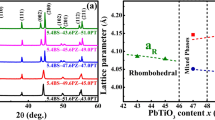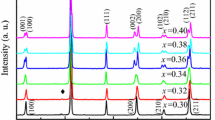Abstract
High-temperature piezoelectric ceramics (0.95 − x)BiScO3–xPbTiO3–0.05Pb(Yb1/2Nb1/2)O3 (BS–xPT–PYN, x = 0.56–0.64) were prepared by a conventional solid-state reaction method. X-ray diffraction and Raman spectra demonstrated that the ceramics convert from monoclinic phase (x ≤ 0.58) to tetragonal phase (0.62 ≤ x ≤ 0.64). A phase coexistence of monoclinic and tetragonal in the vicinity of the MPB (x = 0.60) enhances the ferroelectric polarizability by a dynamical conversion between two energy-degenerate states with d33 = 392 pC/N, kp = 53.3% and Pr = 38.8 μC/cm2 and the operation temperature up to ~ 400 °C. Relaxor behaviors, which following the V–F law, are presented in this system and their dipole activation energy decrease for higher component x. The phase fraction versus temperature of the MPB (x = 0.60) was investigated by an in situ XRD, which gives an insight into the origin of the high-temperature piezoelectricity.









Similar content being viewed by others
References
Zhang S, Li F, Jiang X, Kim J, Luo J, Geng X (2015) Advantages and challenges of relaxor-PbTiO3 ferroelectric crystals for electroacoustic transducers-a review. Prog Mater Sci 68:1–66. https://doi.org/10.1016/j.pmatsci.2014.10.002
Chen J, Jin G, Wang C-M, Cheng J, Damjanovic D (2014) Reduced dielectric loss and strain hysteresis in Fe and Mn comodified high-temperature BiScO3–PbTiO3 ceramics. J Am Ceram Soc 97:3890–3896. https://doi.org/10.1111/jace.13224
Dai Z, Liu W, Lin D, Ren X (2018) Electrical properties of zirconium-modified BiScO3–PbTiO3 piezoelectric ceramics at re-designed phase boundary. Mater Lett 215:46–49. https://doi.org/10.1016/j.matlet.2017.12.036
Deng B, Wei Q, He C, Wang Z, Yang X, Long X (2019) Effect of Pb(Mn1/3Sb2/3)O3 addition on the electrical properties of BiScO3–PbTiO3 piezoelectric ceramics. J Alloys Compd 790:397–404. https://doi.org/10.1016/j.jallcom.2019.03.109
Chen J, Liu G, Cheng J, Dong S (2015) Actuation performance and heat generation of shear-bending actuator based on BiScO3–PbTiO3 ceramics from 25 to 300°C. Appl Phys Lett 107:032906. https://doi.org/10.1063/1.4927328
Jia H, Hu X, Chen J (2019) Temperature-dependent piezoelectric strain and resonance performance of Fe2O3-modified BiScO3–PbTiO3-Pb(Nb1/3Mn2/3)O3 ceramics. J Eur Ceram Soc 39:2348–2353. https://doi.org/10.1016/j.jeurceramsoc.2019.02.013
Zhang S, Lebrun L, Rhee S, Eitel RE, Randall CA, Shrout TR (2002) Crystal growth and characterization of new high Curie temperature (1-x)BiScO3-x PbTiO3 single crystals. J Cryst Growth 236:210–216. https://doi.org/10.1111/jace.13224
Liu Z, Zhao C, Xie R, Wu J (2018) Tailored electrical properties in ternary BiScO3–PbTiO3 ceramics by composition modification. Ceram Int 44:8057–8063. https://doi.org/10.1016/j.ceramint.2018.01.247
Kang H, Chen J, Liu L et al (2012) Preparation and electrical properties of high-T C piezoelectric ceramics of strontium-substituted Bi(Ni1/2Ti1/2)O3-PbTiO3. J Am Ceram Soc 95:1170–1173. https://doi.org/10.1111/j.1551-2916.2012.05078.x
Zhang Q, Li Z, Li F, Xu Z, Yao X (2010) Temperature dependence of dielectric/piezoelectric properties of (1-x)Bi(Mg1/2Ti1/2)O3-xPbTiO3 ceramics with an MPB composition. J Am Ceram Soc 93:3330–3334. https://doi.org/10.1111/j.1551-2916.2010.03860.x
Fan L, Chen J, Li S et al (2013) Enhanced piezoelectric and ferroelectric properties in the BaZrO3 substituted BiFeO3-PbTiO3. Appl Phys Lett 102:022905. https://doi.org/10.1063/1.4775763
Fan L, Chen J, Kang H et al (2012) Structure, piezoelectric, and ferroelectric properties of BaZrO3 substituted Bi(Mg1/2Ti1/2)O3-PbTiO3 perovskite. J Appl Phys 111:104118. https://doi.org/10.1063/1.4722286
Chen J, Li J, Fan L et al (2012) Enhanced piezoelectric and antiferroelectric properties of high-T C perovskite of Zr-substituted Bi(Mg1/2Ti1/2)O3-PbTiO3. J Appl Phys 112:074101. https://doi.org/10.1063/1.4755790
Hu Q, Wang Y, Wu L et al (2018) Effects of LiNbO3 doping on the microstructures and electrical properties of BiScO3–PbTiO3 piezoelectric system. J Mater Sci Mater Electron 29:18036–18044. https://doi.org/10.1007/s10854-018-9898-y
Zhao H, Hou Y, Yu X, Zheng M, Zhu M (2018) Construction of high T c BiScO3–BiFeO3–PbTiO3 and its enhanced piezoelectric properties by sintering in oxygen atmosphere. J Appl Phys 124:194103. https://doi.org/10.1063/1.5055297
Zhang S, Yu Y, Wu J, Gao X, Huang C, Dong S (2018) Enhanced piezoelectric performance of BiScO3–PbTiO3 ceramics modified by 0.03Pb (Sb1/2Nb1/2)O3. J Alloys Compd 731:1140–1145. https://doi.org/10.1016/j.jallcom.2017.10.052
Talanov MV, Bush AA, Кamentsev KE, Sirotinkin VP, Segalla AG (2018) Structure-property relationships in BiScO3–PbTiO3–PbMg1/3Nb2/3O3 ceramics near the morphotropic phase boundary. J Am Ceram Soc 101:683–693. https://doi.org/10.1111/jace.15225
Zhao T-L, Chen J, Wang C-M, Yu Y, Dong S (2013) Ferroelectric, piezoelectric, and dielectric properties of BiScO3–PbTiO3–Pb(Cd1/3Nb2/3)O3 ternary high temperature piezoelectric ceramics. J Appl Phys 114:027014. https://doi.org/10.1063/1.4812223
Ohuchi H, Tsukamoto S, Ishii M, Hayakawa H (1999) Piezoelectric and structural properties of Pb(Yb1/2Nb1/2)O3–PbTiO3–PbZrO3 ceramics. J Eur Ceram Soc 19:1191–1195. https://doi.org/10.1016/s0955-2219(98)00402-6
Yamamoto T, Ohashi S, Hisano K (1997) Ferroelectric and crystallographic properties of Pb(Yb1/2Nb1/2)O3-PbTiO3 solid solution system. Ferroelectrics 196:281–284. https://doi.org/10.1080/00150199708224180
Duran C, Trolier-Mckinstry S, Messing GL (2003) Processing and electrical properties of 0.5Pb(Yb1/2Nb1/2)O3-0.5PbTiO3 ceramics. J Electroceram 10:47–55. https://doi.org/10.1023/A:1024080008850
Kwon JR, Choo CKK, Choo WK (1991) Dielectric and X-ray diffraction studies in highly ordered complex perovskite Pb(Yb1/2Nb1/2)O3. Jpn Appl Phys 30:1028–1033. https://doi.org/10.1143/JJAP.30.1028
Noheda B, Cox DE, Shirane G, Guo R, Jones B, Cross LE (2000) Stability of the monoclinic phase in the ferroelectric perovskite PbZr1-xTixO3. Phys Rev B 63:014103. https://doi.org/10.1103/PhysRevB.63.014103
Pandey D, Singh AK, Baik S (2007) Stability of ferroic phases in the highly piezoelectric Pb(ZrxTi1-x)O3 ceramics. Acta Crystallogr Sect A Found Crystallogr 64:192–203. https://doi.org/10.1107/s0108767307055511
Chaigneau J, Kiat JM, Malibert C, Bogicevic C (2007) Morphotropic phase boundaries in (BiScO3)1−x(PbTiO3)x (0.60 < x<0.75) and their relation to chemical composition and polar order. Phys Rev B 76:094111. https://doi.org/10.1103/PhysRevB.76.094111
Burns G, Scott BA (1973) Lattice modes in ferroelectric perovskites: PbTiO3. Phys Rev B 7:3088. https://doi.org/10.1103/PhysRevB.7.3088
Schütz D, Deluca M, Krauss W, Feteira A, Reichmann K (2012) Lone-pair-induced covalency as the cause of temperature-and field-induced instabilities in bismuth sodium titanate. Adv Funct Mater 22:2285–2294. https://doi.org/10.1002/adfm.201102758
Chen J, Shi H, Liu G, Cheng J, Dong S (2012) Temperature dependence of dielectric, piezoelectric and elastic properties of BiScO3–PbTiO3 high temperature ceramics with morphotropic phase boundary (MPB) composition. J Alloys Compd 537:280–285. https://doi.org/10.1016/j.jallcom.2012.05.041
Yao Z, Liu H, Cao M, Hao H (2010) Effects of Nb doping on the microstructures and electrical properties of 0.44Bi(Sc0.75Co0.25)O3-0.56PbTiO3 piezoelectric system. J Alloys Compd 505:281–285. https://doi.org/10.1016/j.jallcom.2010.06.047
Ryu J, Priya S, Uchino K (2003) High-T m relaxor ferroelectrics: 0.3BiScO3–0.6PbTiO3-0.1Pn1/3Nb2/3)O3. Appl Phys Lett 82:251. https://doi.org/10.1063/1.1536028
Deng J, Sun X, Liu L et al (2016) Dielectric properties of SrMnO3-doped K0.5Na0.5NbO3 lead-free ceramics. J Electron Mater 45:4089–4099. https://doi.org/10.1007/s11664-016-4595-1
Liu J, Li F, Zeng Y et al (2017) Insights into the dielectric response of ferroelectric relaxors from statistical modeling. Phys Rev B 96:054115. https://doi.org/10.1103/PhysRevB.96.054115
Liu L, Knapp M, Ehrenberg H et al (2017) Average vs. local structure and composition-property phase diagram of K0.5Na0.5NbO3-Bi½Na½TiO3 system. J Eur Ceram Soc 37:1387–1399. https://doi.org/10.1016/j.jeurceramsoc.2016.11.024
Viehland D, Jang SJ, Cross LE, Wuttig M (1990) Freezing of the polarization fluctuations in lead magnesium niobate relaxors. J Appl Phys 68:2916. https://doi.org/10.1063/1.346425
Pirc R, Blinc R (2007) Vogel–Fulcher freezing in relaxor ferroelectrics. Phys Rev B 76:020101. https://doi.org/10.1103/PhysRevB.76.020101
Raengthon N, Sebastian T, Cumming D, Reaney IM, Cann DP, Roedel J (2012) BaTiO3–Bi(Zn1/2Ti1/2)O3–BiScO3 ceramics for high-temperature capacitor applications. J Am Ceram Soc 95:3554–3561. https://doi.org/10.1111/j.1551-2916.2012.05340.x
Chu F, Reaney IM, Setter N (1994) Investigation of relaxors that transform spontaneously into ferroelectrics. Ferroelectrics 151:343–348. https://doi.org/10.1080/00150199408244759
Acknowledgements
Funding was provided by Natural Science Foundation of China (Grant Nos. 11564010, 51402196, 51602159, 11574246 and U1537210), National Basic Research Program of China (Grant No. 2015CB654903), Natural Science Foundation of Guangxi (Grant Nos. GA139008, AA138162, AA294014, CB380006, FA198015).
Author information
Authors and Affiliations
Corresponding authors
Ethics declarations
Conflict of interest
The authors declare that they have no conflict of interest.
Additional information
Publisher's Note
Springer Nature remains neutral with regard to jurisdictional claims in published maps and institutional affiliations.
Rights and permissions
About this article
Cite this article
Lan, Z., Liu, J., Ren, S. et al. Phase evolution and relaxor behavior of BiScO3–PbTiO3–0.05Pb(Yb1/2Nb1/2)O3 ternary ceramics. J Mater Sci 54, 13467–13478 (2019). https://doi.org/10.1007/s10853-019-03851-8
Received:
Accepted:
Published:
Issue Date:
DOI: https://doi.org/10.1007/s10853-019-03851-8




